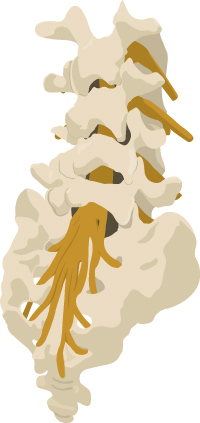Cauda equina syndrome is a serious condition caused by the compression and inflammation of the bundle of nerves in the lower section of the spinal canal. Because it may result in paralysis, bowel/bladder incontinence and other sensation and movement problems if left untreated, spine surgery is typically required.
 What Is Cauda Equina Syndrome?
What Is Cauda Equina Syndrome?
The spinal cord extends from the base of the brain to the area between the bottom of the first lumbar vertebra and the top of the second lumbar vertebra, and its main function is the transmission of nerve signals between the peripheral nervous system and the brain.
The spinal cord ends by diverging into individual nerves that travel out to the lower body and legs. Because of its appearance, this group of nerves is called the cauda equina – the Latin name for “horse’s tail.” Cauda equina syndrome is caused by significant narrowing of the spinal canal that compresses the nerve roots below the level of the spinal cord.
What Are The Symptoms Of Cauda Equina Syndrome?
Symptoms of cauda equina syndrome include:
- Localized or radiating low back pain
- Leg pain that starts in the buttocks and travels down the back of the thighs
- Numbness in the groin or “saddle” area
- Bowel and bladder impairment
- Lower extremity muscle weakness and loss of sensation
- Reduced or absent lower extremity reflexes
The causes of cauda equina syndrome can include:
- Traumatic injury
- Disc herniation
- Spinal stenosis
- Spinal tumors
- Inflammatory conditions, such as ankylosing spondylitis
- Infection in the spinal canal
- Previous medical procedures (i.e., spinal tap, continuous spinal anesthesia or out-of-position instrumentation)
 Cauda equina syndrome is considered a surgical emergency. Please seek immediate medical care or go to your local emergency room if you believe you’ve developed the symptoms of cauda equina syndrome.
Cauda equina syndrome is considered a surgical emergency. Please seek immediate medical care or go to your local emergency room if you believe you’ve developed the symptoms of cauda equina syndrome.
Some of the early symptoms related to cauda equina syndrome, including low back pain and muscle weakness, are similar to those associated with less serious spinal conditions, such as disc herniation, that do not require urgent care. However, if you develop severe pain or loss of sensation or bowel or bladder problems, you should contact your physician immediately.
How Is Cauda Equina Syndrome Diagnosed?
To determine whether you have cauda equina syndrome, your provider will examine your back and your medical history, and may order an x-ray, bone scan, myelogram, computed tomography (CT) scan and/or magnetic resonance imaging (MRI) to rule out another disorder as the cause of your symptoms.
How Is Cauda Equina Syndrome Treated?
In many cases of cauda equina syndrome, surgical decompression of the spinal canal typically is recommended as the most appropriate treatment option. The goal is to relieve pressure on the cauda equina nerves by removing the compressing structures and increasing the space available for the nerves in the spinal canal.
In addition to decompressing the affected nerves in the cauda equina, your provider also will seek to treat the underlying cause of the condition. Patients with infections or tumors, for example, may be prescribed antibiotics or chemotherapy; removal of the bone and/or disc material (laminectomy or discectomy) may be recommended for those whose cauda equina syndrome was caused by a herniated disc.
The benefits of spine surgery, however, must be weighed against the risks. Your surgeon will be able to discuss the risks and benefits of surgery with you, and the likely results of operative versus non-operative treatment.

